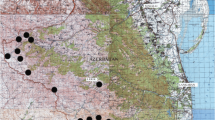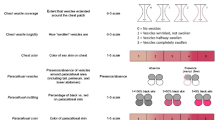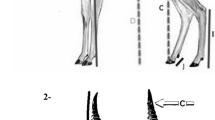Abstract
The efficacy of the perineal stain as an index for sexual maturity and breeding condition in the male greater cane rat, Thryonomys swinderianus, Temminck, was investigated in 34 animals collected from hunters' kills in the Ekumfi District of Ghana, between April and June 1989. The results indicated that, although the presence of the perineal stain was conclusive proof of sexual maturity in an individual, it was not efficacious as an index for sexual maturity for biological work in these animals (p>0.05), because it excluded some that, although sexual mature, did not exhibit the trait, particularly young adults. However, the perineal stain may be useful as a management tool for identifying sexually mature captive greater cane rats. About 7 out of every 10 caught each month were found to be in breeding condition.
Similar content being viewed by others
REFERENCES
Addo, P.G.A., 1998. Domesticating the wild grasscutter (Thryonomys swinderianus, Temminck, 1827) under laboratory condition, (PhD thesis, University of Ghana, Legon, Ghana)
Adjanohoun, E., 1989. Contribution au development de l'elevage de l'aulacode (Thryonomys swinderianus, Temminck, 1827) et a l'etude de sa reproduction, (Agence de Cooperation Culturelle et Technique, Paris)
Adu, E.K. and Yeboah, S., 2000. The efficacy of the vaginal plug formation after mating for pregnancy diagnosis; and embryonic resorption in utero in the greater cane rat (Thryonomys swinderianus, Temminck). Tropical Animal Health and Production, 32, 1-10
Asibey, E.O.A., 1974. Some ecological and economic aspects of the grasscutter, Thryonomys swinderianus, Tem in Ghana, (PhD thesis, University of Aberdeen, UK)
Asibey, E.O.A., 1981. Maternal and neo-natal weight in the grasscutter, Thryonomys swinderianus (Temminck), in Ghana. African Journal of Ecology, 19, 355-360
Ewer, R.F., 1969. Form and function in the grasscutter, Thryonomys swinderianus, Temn. (Rodentia, Thryonomidae). Ghana Journal of Science, 9, 131-141
Grimstone, A.V. and Skaer, R.J., 1972. A Guide Book to Microscopical Methods, (Cambridge University Press, Cambridge)
Morris, T.R., 1999. Experimental Design and Analysis in Animal Sciences, (CABI Publishing, Wallingford)
SAS, 1996. The SAS System for Windows, Release 6.12, (SAS Institute Inc., Cary, NC)
Schrage, R. and Yewadan, L.T., 1999. Raising Grasscutters, (Deutsche Gesellschaft für Technische Zusammenarbeit (GTZ) GmbH, Eschborn)
Skinner, J.D. and Smither, R.H.N., 1990. The Mammals of the Southern African Subregion, 2nd edn, (Pretoria University, Pretoria)
Yeboah, S., 1982–1988. The ecology of the multimammate mouse (Praomys natalensis) and the spotted mouse (Lemniscomys striatus) in eastern Ghana. Ghana Journal of Science, 22–28, 65-74
Yeboah, S., 1989–1990. Ecological studies on the fat mouse Steatomys parvus cuppedius (Rodentia: Muridae) in Ghana: population and reproductive biology. Ghana Journal of Science, 29–30, 25-30
Author information
Authors and Affiliations
Rights and permissions
About this article
Cite this article
Adu, E., Yeboah, S. On the Use of the Perineal Stain as an Index of Sexual Maturity and Breeding Condition in the Male Greater Cane Rat, Thryonomys swinderianus, Temminck. Tropical Animal Health and Production 35, 433–439 (2003). https://doi.org/10.1023/A:1025867512986
Issue Date:
DOI: https://doi.org/10.1023/A:1025867512986




